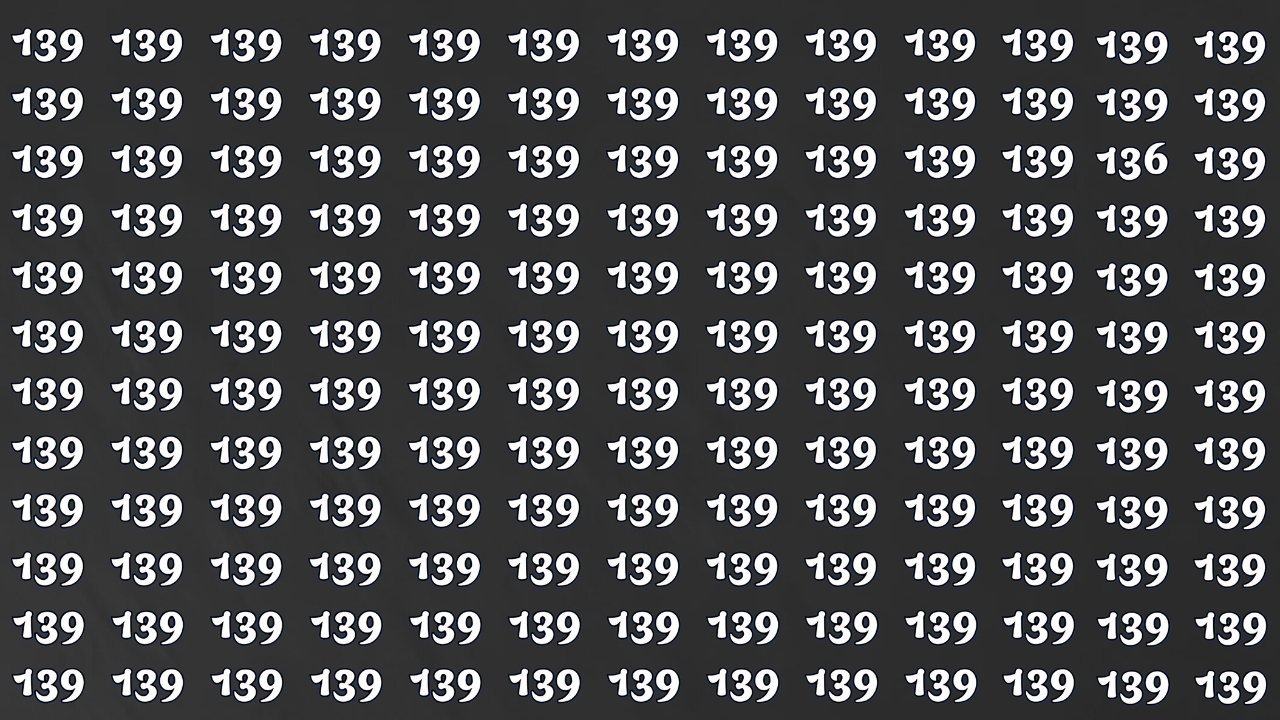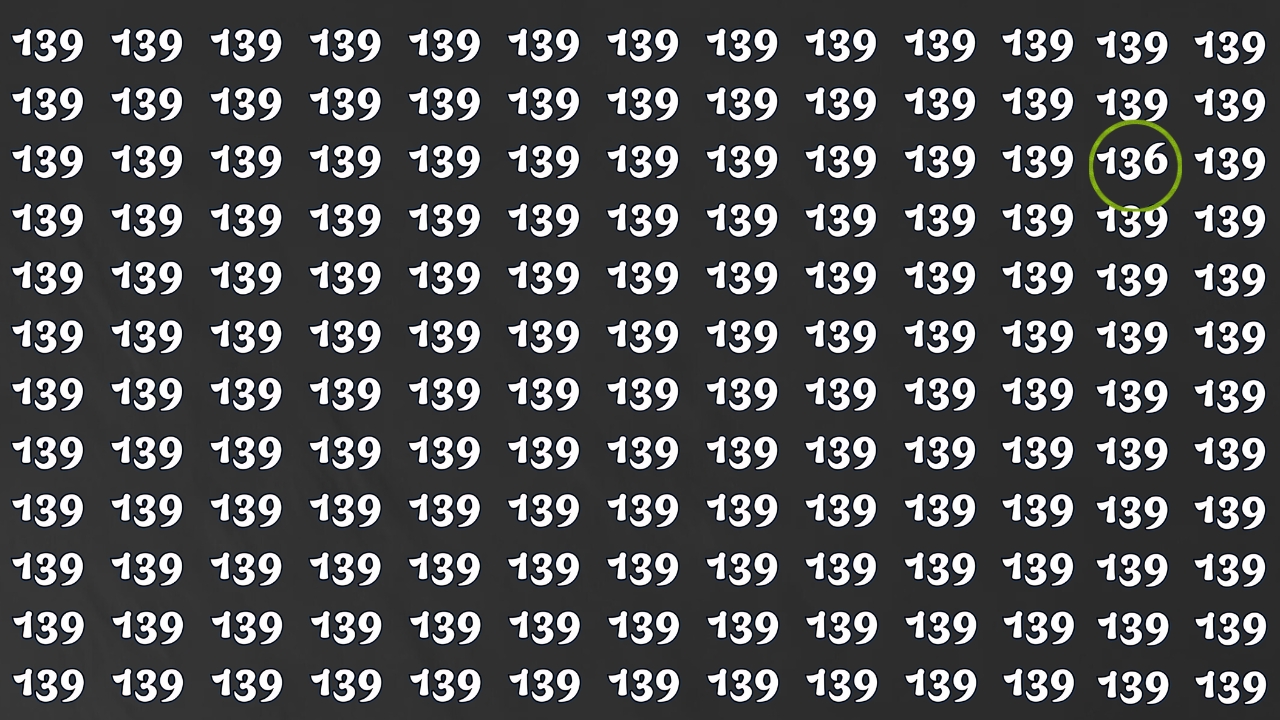Find Hidden Number 136 : you’re scrolling through social media when suddenly a friend challenges you to find a number hidden in what looks like visual chaos. Your competitive spirit kicks in, and before you know it, you’re staring intensely at your screen, trying to spot the number 136 cleverly concealed among dozens of 139s. Welcome to the world of viral optical illusion challenges that are taking the internet by storm.
What Makes This Challenge So Addictive?
There’s something incredibly satisfying about solving visual puzzles, especially when there’s a time pressure involved. This particular challenge gives you just eight seconds to locate the number 136 hiding in plain sight among a sea of similar-looking 139s. It sounds simple enough, right? Yet millions of people find themselves repeatedly attempting this challenge, sometimes sharing screenshots with friends and family to see who can spot it fastest.
The beauty of this type of puzzle lies in its deceptive simplicity. At first glance, your eyes see rows and columns of what appears to be identical numbers. Your brain, always looking for patterns and shortcuts, initially processes all the numbers as the same. This is where the challenge becomes fascinating from a neurological perspective.
Understanding How Your Brain Processes Visual Information

When you look at this optical illusion, your brain goes through several rapid processes. First, it attempts to categorize and group similar visual elements together. This evolutionary trait helped our ancestors quickly identify threats or opportunities in their environment. However, this same efficiency can work against us in puzzles like this one.
Your visual cortex processes information in layers, starting with basic shapes and lines, then moving to more complex pattern recognition. When confronted with repetitive elements like multiple “139” numbers, your brain tends to create a mental template and assumes all similar-shaped elements fit that template. This is why the hidden “136” becomes nearly invisible despite being right there in front of you.
The challenge becomes even more interesting when you consider peripheral vision. Many people find that they can spot the hidden number more easily when they’re not looking directly at it. This happens because different parts of your retina have varying sensitivities to detail and movement.
Why These Challenges Are More Than Just Fun
Beyond the entertainment value, visual puzzles like this one offer genuine cognitive benefits. Regular engagement with optical illusions and visual challenges can improve your attention span, enhance pattern recognition skills, and even boost your ability to focus under pressure.
Think about it this way: every time you attempt to solve one of these puzzles, you’re essentially giving your brain a workout. You’re training your visual processing system to become more efficient at filtering relevant information from background noise. This skill translates surprisingly well to real-world situations, from quickly finding items in a crowded store to spotting important details in work documents.
The Social Media Phenomenon
What’s particularly interesting about challenges like the 136-among-139s puzzle is how they spread across social platforms. People love sharing these challenges because they create an instant connection point. There’s something universally appealing about testing your skills against others, and the eight-second time limit adds just enough pressure to make it exciting without being overwhelming.
The viral nature of these puzzles also speaks to our desire for shared experiences. When someone posts their attempt time or asks friends to try the challenge, they’re creating a moment of collective engagement. It’s a form of social bonding that transcends age groups and cultural boundaries.
Strategies for Improving Your Visual Search Skills
If you’ve tried this challenge and found it frustrating, don’t worry. There are techniques you can use to improve your visual search abilities. One effective approach is to systematically scan the image rather than letting your eyes dart around randomly. Try moving from left to right, top to bottom, examining each section carefully.
Another helpful technique is to slightly unfocus your eyes, allowing your peripheral vision to take over. Sometimes the hidden element becomes more apparent when you’re not staring directly at it. This works because peripheral vision is more sensitive to differences and movement.
Some people find success by looking for visual anomalies rather than searching for the specific number. Instead of thinking “I need to find 136,” try thinking “I need to find something that doesn’t match the pattern.” This subtle shift in mindset can make a significant difference in your success rate.
The Psychology Behind Time Pressure
The eight-second time limit isn’t arbitrary – it’s carefully chosen to create the perfect amount of stress to make the challenge engaging without being impossible. This duration is long enough for most people to have a chance at success but short enough to prevent overthinking.
Time pressure activates different parts of your brain compared to leisurely observation. Under pressure, your brain tends to rely more heavily on intuitive processing rather than methodical analysis. This can actually work in your favor for challenges like this, as your subconscious pattern recognition systems might spot the anomaly before your conscious mind catches up.
Building Community Through Shared Challenges
One of the most remarkable aspects of optical illusion challenges is how they bring people together. Families gather around devices to attempt them together, office colleagues take breaks to try them, and social media becomes filled with people sharing their results and challenging others.
These shared experiences create bonds and memories. Think about how often you’ve had conversations that started with “Did you see that puzzle where you had to find…” These moments of connection are valuable in our increasingly digital world.
Optical Illusion Answer

While trends come and go on social media, optical illusions and visual challenges have remarkable staying power. This is because they tap into fundamental aspects of human psychology and neurology that remain constant regardless of technological changes.
The satisfaction of solving a visual puzzle triggers the same reward pathways in your brain that have motivated human problem-solving for thousands of years. Whether our ancestors were tracking animals or modern people are finding hidden numbers, the underlying psychological mechanisms remain the same.
The next time you encounter a challenge like finding 136 among 139s, remember that you’re participating in something much larger than a simple internet trend. You’re engaging in a form of mental exercise that strengthens your cognitive abilities while connecting with others through shared experience.
So go ahead, set your timer for eight seconds, and see if you can join the ranks of those with “eagle eyes” who can spot the hidden number. Whether you succeed immediately or need several attempts, you’re giving your brain valuable exercise and potentially discovering new aspects of how your visual system works.